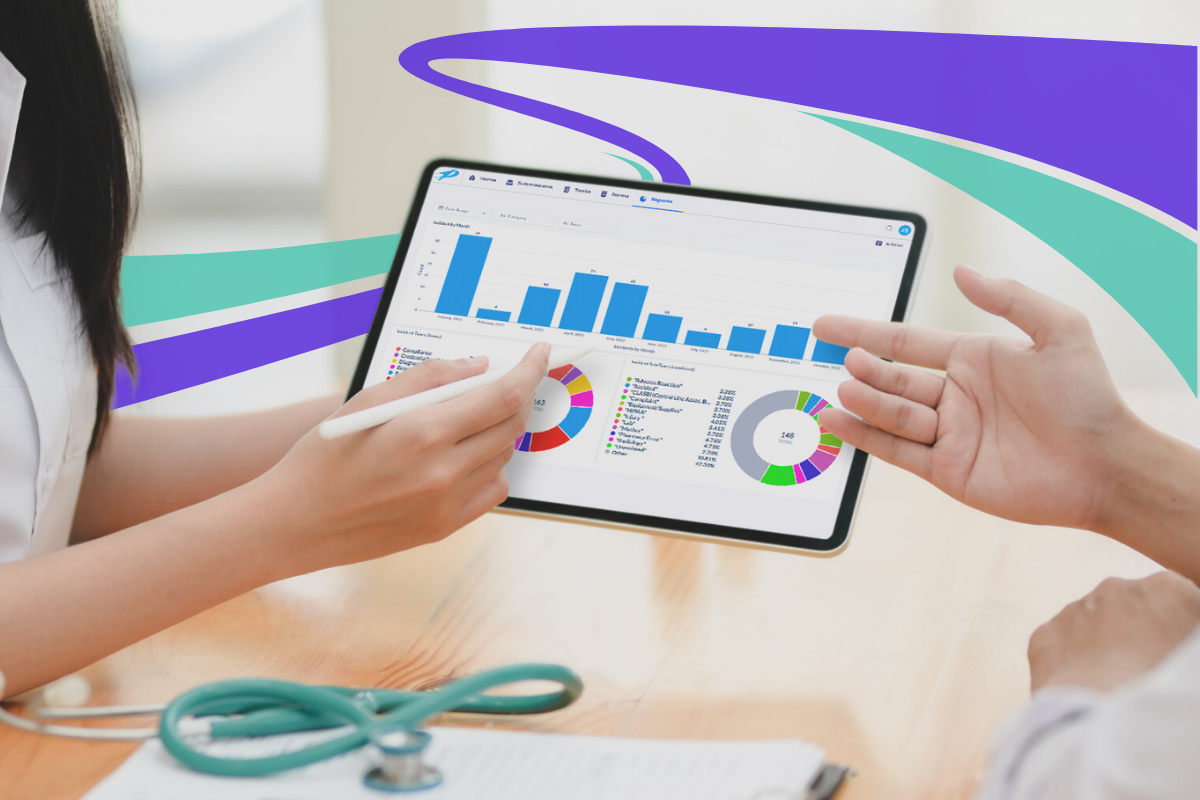5 min read
Metrics that Matter: Enhancing Safety with Healthcare Dashboards
Performance Health Partners
January 13, 2025

In healthcare, every data point can mean the difference between a close call and a critical incident for patient safety. A healthcare incident reporting system is essential for capturing key data points and converting them into meaningful insights.
These insights are presented through intuitive, healthcare dashboards that empower management to monitor safety trends, proactively identify risks, and implement timely, effective solutions to enhance patient and employee safety.
By tracking the right metrics, healthcare organizations can use real-time dashboards to improve patient safety and streamline operations. This blog post delves into how data-driven tools can drive safer care, highlighting key metrics, their impact, and best practices for optimizing healthcare data analytics across organizations.
The Role of Incident Reporting Systems in Patient Safety
As healthcare technology reshapes the healthcare landscape, incident reporting systems have become invaluable tools for advancing patient safety. A healthcare incident reporting system provides a centralized platform for documenting adverse events, near misses, and potential risks, allowing organizations to identify patterns and vulnerabilities.
By consistently documenting and analyzing incidents, healthcare teams gain valuable insights into gaps and shortcomings of existing safety processes. This data not only highlights areas for improvement but also drives meaningful change—whether through creating new policies, allocating resources more effectively, or implementing proactive measures to prevent future risks.
Integrated into patient safety dashboards, healthcare data analytics provide healthcare leaders with real-time performance assessments, enabling them to identify issues and take timely, informed actions to enhance care.
Why Metrics Matter for Healthcare Dashboards
Metrics are the foundation of informed decision-making in healthcare. While incident reporting systems capture critical data, it’s the transformation of this data into actionable metrics through healthcare dashboards that enables organizations to move beyond simply reacting to incidents and other types of safety events.

Dashboards provide a comprehensive view of safety trends, highlighting not just what went wrong but uncovering patterns such as where, when, and how incidents occur. With access to detailed metrics like incident frequency, type, and location, healthcare leaders can go deeper—evaluating systemic issues, comparing performance across units, and identifying areas needing immediate attention, all while taking a data-driven approach to decision making.
Moreover, dashboards enable organizations to track progress over time, measuring the impact of interventions and adapting strategies as needed. This continuous feedback loop is what empowers teams to shift from reactive risk management to proactive harm prevention, driving a culture of safety and accountability.
Top Metrics to Include in a Patient Safety Dashboard
To maximize the benefits of healthcare dashboards, organizations need to focus on metrics that offer a holistic view of their performance.

Some top metrics to include in a patient safety dashboard are:
Incident Volume
Incident volume reflects the frequency of incidents being reported, serving as a great metric for understanding the status of overall safety efforts within the organization.
For example, a sudden spike in incidents could indicate a need for immediate review to determine whether the reason was an internal error, such as lack of staff training, or an uncontrollable external factor, such as the season or day of the week.
By analyzing incident volume over time, management can identify patterns, assess the impact of current safety initiatives, and allocate resources to areas that may require additional support.
Incident Type
Categorizing incidents by type, such as medication errors, in-patient falls, or workplace violence, is an important metric for pinpointing which types of incidents are most common and therefore pose the greatest risk to patient safety.
If management notices that medication errors occur frequently, additional medication management training may be necessary to provide staff with the resources they need to prevent harm effectively. Tracking incident types not only highlight areas for improvement but also helps leadership to take the proper preventative measures to decrease future occurrences.
Location of Incident
Tracking the location in which incidents occur allows management to identify potential high-risk areas or identify patterns that are tied to a specific department within the facility.
For instance, if a specific ward had a high volume of incidents in the past month, increased staffing might be warranted to reduce risks in that area. In addition, tracking the location of incidents by type, such as medication errors or falls, helps focus intervention strategies on more specific types of risk.
Harm Severity Levels
Assessing the level of harm associated with each incident is essential for prioritizing response time and resource allocation for more severe incidents of harm. This is crucial because harm levels can range from near misses—events that could have resulted in harm but did not—to severe injuries or even fatal outcomes, underscoring the need for quick and timely responses.
This metric can also help organizations determine whether safety interventions are effective or not, as a decrease in high-severity incidents can indicate improved patient safety practices.
Time to Resolution
Analyzing the time to resolution is a crucial metric, as it shows how promptly and effectively an organization is currently addressing safety incidents. By tracking the average amount of time it takes to investigate and resolve incidents, risk management can identify delays, allocate more resources, and communicate with teams to reinforce a sense of urgency and accountability in addressing patient safety.
Root Cause Categories
Root causes—such as human error, equipment issues, or environmental factors—serve as the identifier for how or why an incident occurred. By compiling root causes into one comprehensive metric, healthcare organizations can address these underlying issues through targeted interventions.
Performing a root cause analysis is essential for preventing recurrence of incidents and can pinpoint other areas for improvement within the organization.
Actionable Follow-up Metrics
After an incident has been resolved, it’s crucial to make post-incident follow-ups to ensure preventive measures are being enforced. This includes tracking the percentage of incidents that have been addressed by corrective action as well as closed feedback loops with staff. Keeping staff informed of updates in incident report resolution can boost employee morale and improve psychological safety, reassuring employees that leadership is taking the proper steps to address concerns.
Best Practices for Optimizing Your Patient Safety Dashboard
For a patient safety dashboard to be effective, it should be designed with best practices in mind. Some factors to consider in the optimization of your patient safety dashboard include:
- Customization: Every healthcare organization is unique, with distinct priorities and needs, making customization essential for optimizing healthcare dashboards. As such, customization is crucial to tailor dashboards for maximum efficiency. Continuously assessing and refining categories and fields based on emerging trends ensures teams can focus on the most relevant metrics, driving efficiency and advancing patient safety goals.
- Real-Time Data Access: Real-time data access empowers management to monitor incidents and events as they unfold, and make timely, informed decisions. This immediacy is crucial not only in critical situations but also in efficiently addressing minor issues before they escalate, ensuring a safer and more responsive environment.
- Data Visualization: Complex metrics can be challenging to interpret, especially when quick decisions are needed. Dashboards should present both the big picture and daily snapshots in clear, easily digestible formats like graphs and charts. This ensures managers can quickly grasp key insights, enabling faster and more effective decision-making.
- User-friendly Interface: A well-designed healthcare dashboard presents data concisely and intuitively, making it easier to identify anomalies and trends at a glance. Visuals should be clear and accessible to both staff and leadership, allowing users to quickly navigate and understand key metrics. An effective patient safety dashboard simplifies incident breakdowns with just a click, ensuring everyone can grasp the importance of patient safety metrics and take informed action.
Leveraging an incident reporting system built on best practices, with pre-built dashboards that fully incorporate these principles, empowers organizations to elevate patient safety and drive transformative quality improvement.
Data-driven healthcare dashboards are a powerful tool for enhancing patient safety. By investing in a robust incident reporting system that provides real-time data, healthcare organizations can effectively monitor safety efforts, identify trends, and evaluate outcomes.
These dashboards give management the metrics they need to make informed decisions and implement targeted solutions for specific issues. With the right tools and a focus on tracking meaningful metrics, healthcare teams can create safer, more reliable care environments and continuously improve the patient experience.
Ready to Learn More?
Find out how Performance Health Partners’ best-in-class incident management system can help transform your patient safety program. Connect with us to get a personalized demo.



